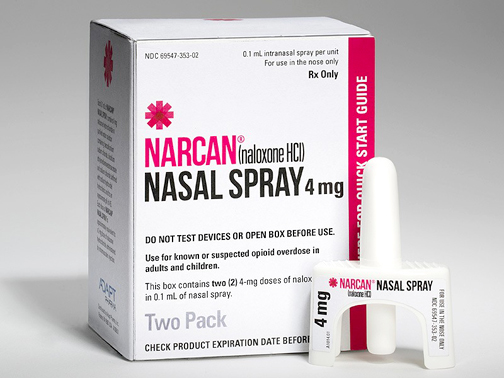Opioid overdose rates have tripled since 2000 with more deaths reported in the United States in 2014 than in any previous year on record, according to a report issued in 2016 by the Food and Drug Administration titled “Naloxone for Treatment of Opioid Overdose.” According to the FDA, there were a total of 47,055 drug overdose deaths in the U.S. in 2014. Of these, prescription opioid analgesics and heroin accounted for 28,647 deaths.
It is these statistics, and personal experience, that has led the Los Angeles County Sheriff’s Dept. to begin a new program to have patrol deputies carry naloxone, Narcan, in their patrol units. Narcan is a medicine that blocks the effects of opioids and reverses an overdose.
The program is in the preliminary stage, said Commander Judy Gerhardt, who has taken the lead for the program.
In 2015, according to the Centers for Disease Control and Prevention, the five states with the highest rates of death due to drug overdose were West Virginia, New Hampshire, Kentucky, Ohio and Rhode Island. Several states in the East have shown increases in overdose death rates. Gerhardt said although California and specifically Los Angeles County has not seen that great an increase this program is a proactive way to be ready, “if it does hit us in a big way.”
Sheriff Jim McDonnell had asked his staff to conduct research into this issue and believed it was important for deputies to be prepared.
Narcan is a prescription drug in the form of a nasal spray and has been referred to as an opiate antidote. Opioids include pain medication, like prescription oxycodone, hydrocodone and morphine. Heroin is also an opioid.
Since Gerhardt picked up the mantle of this program she has become a driving force behind it, not just because of what she has seen over her 37 years with LASD but because this opioid epidemic has touched her life in a very personal way.
“My nephew died in December [2016],” she said.
Her brother, Dr. James Baker, in an interview with NPR (National Public Radio), said his son Max Baker began using prescription pills as a teenager in New England. That addiction quickly moved to heroin. Baker had seen signs of his son’s addiction and “begged him to stop.”
Max had gone through treatment and had gotten his life back on track. According to the NPR interview, Max had been prescribed an opioid called suboxone that is used to wean people off opioids. The prevention medication worked and in about a year he had worked his way off of that medication. He completed high school and earned a two-year Associate of Arts degree. He had signed up to attend the University of Massachusetts, but then in late 2016 a vehicle pulled out in front of him, there was a collision and everything changed.
Max had broken his hand and surgery was required. This is often difficult for addicts of prescription drugs because of the anesthesia and following pain medication prescribed for those patients. Max had been up front with his doctors about his concern. The surgeon spoke with Baker about his son’s treatment. Eventually the anesthesiologist decided that because they had other patients who had been on suboxone and were able to go through the process without a setback, they would go forward with Max.
Later, as the healing process began, Max asked the surgeon for stronger pain medication. The surgeon was concerned that Max would self-medicate if he didn’t prescribe something, so he did – a small amount of Vicodin.
On Dec. 28, 2016, “He was found dead from an overdose alone on the bathroom floor,” Baker wrote in an op-ed for telegram.com in Worcester, Massachusetts. Max had died of a heroin overdose.
Just prior to his death Max had shared his opinion on his addiction and how best to approach those who were addicted. Baker shared his son’s feelings regarding Narcan.
“Narcan needs to be available everywhere. Schools, police, firefighters, shelters, businesses – it needs to be out there as long as this epidemic is here. We can help people stay alive until they can find recovery. Addicts should also have it so they can save each other and then try to get better,” Baker wrote.
Gerhardt said she has seen how the community in Worcester has rallied around this issue and how Narcan has been distributed to early responders. While Massachusetts has seen significant increases in overdose deaths. She wants Los Angeles County to be ready and not to wait for the epidemic to grow larger before taking action.
“We at [LASD] are here to protect and serve, even if it is protecting people from themselves,” she said.
Initially LASD was to distribute 1,200 doses of Narcan to deputies at Crescenta Valley and Santa Clarita stations as well as the Community College and Parks Bureau as part of a pilot program, but last week Gerhardt was informed that 5,000 additional doses were made available through Public Health and, therefore, all of LASD will have this potentially life-saving medication.
“Our goal is to deploy [naloxone] with every field deputy within the next six months,” she said.
LASD is working with several L.A. County departments including Public Health and Emergency Medical Services as well as the LA Board of Supervisors. The training program for deputies is still being processed and approved; however, as soon as it is the dispersal of Narcan will begin.
Gerhardt is proud of what LASD is doing with this program and wants to do more by working with other community organizations that focus on drug prevention and recovery. She also said she realizes that this program can be an intervention step, not a final solution to the opioid epidemic.
“This is just one small step and it may give [overdose victims] one more day,” she said. “I would have liked my nephew to have had one more day.”

